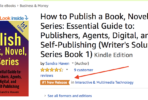Pain-free Ways to Cut Your Manuscript
I just finished writing an article for an organization I belong to, geared to a specific magazine and when I was finished I had 2,355 words. Great! Of course the magazine’s max is only 1,500 words. But that’s the way I like it to be—start with spilling out all your ideas and then hone into the best, the sharpest, and the most pertinent.
The same is true for fiction authors—get the whole book out on paper and only then sort through to find the real gems. However, many writers aren’t sure how to go about cutting without it hurting (themselves OR the book!).
Here are some hints on how to do it with the least amount of pain. First consider that length you really should be aiming for.
- If you consider self-publishing or your intended publisher has no restrictions (those doing e-books in favor of paper books have fewer restrictions), then you might be good to go with what you have!
- If you plan to market to various commercial publishers consider what is the average length restriction among them and for your specific genre too. For instance, fantasies tend to be longer than most other fiction, but, still, publishers have restrictions.
- If you have a specific publisher in mind, you need to consider what their specific maximum length requirement is.
Take a word count of your manuscript and compare it to the length you feel you should aim for, based on the above research. Is it too long? By how much? If you DO end up needing to cut the book down, you have options:
- First, cut scenes. This is the fastest fix. Hopefully you have at least a rough outline of the series of scenes that makes up each chapter. Read through the outline and pick the really outstanding ones—give them a check mark. Then what are the scenes that are really good and supportive to the first you checked. Give them check marks too. Now I’ll bet you have a few unchecked ones left over. Are they all necessary? Could one or more of them really be just paraphrased in the chapter that follows it? Like, “Joe and Alice spent the next two days trekking through …” and then a couple of paragraphs that summarize what you may have spent an entire chapter on before?
- After you’ve done that, figure your word count again compared to your goal. What percentage do you still need to cut (if at all)? Say your goal is 100,000 words and you have 110,000, then you need to cut about 10% more.
- Now cut wording. This fix keeps takes more time but keeps all your great scenes. You can drop a percentage of the wording without a real loss for the story. To get the feel of it, take just one scene and put it in a separate file, count the words and start hacking out words, phrases, extra comments, and any unnecessary tags (the “he saids” aren’t always necessary). Be ruthless because, hey, it is only practice and a separate file anyway, right? Keep the really sharp-witted bits and the strongest details. When you are done I think you will quickly see how removing 10% isn’t so hard and, in fact, improves the pace!
- Then do that to the rest of your manuscript. You’ll get the hang of cutting to just the strengths of your story pretty easily. Not only will your current story end up tighter, but you’ll have added a writing skill that will help you write your next book as well!
Enjoy writing with wild abandon! You can use these tips after the initial writing is one to polish it up until it shines.
Want personal and professional help with your specific book? Contact me!






